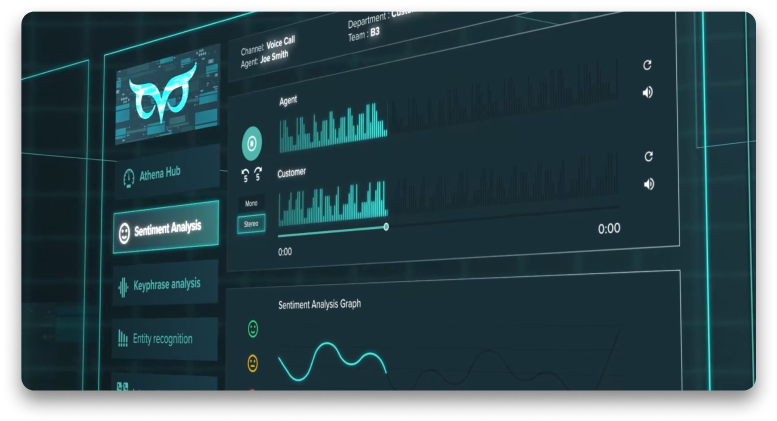According to the World Health Organisation, approximately 15% of the world’s population experiences some form of disability.
Studies conducted by Ofcom found that the needs of disabled people when using communication services, through a contact centre, was a common problem. With only 10% of businesses incorporating a disability and accessibility strategy, there is much improvement to be done in the industry.

Inclusivity for customer service agents
As contact centres globally are faced with massive staff shortages and high employee turnover (reaching attrition rates of 21%), we need to take a closer look into the workforce.
At the end of 2020, there were roughly 8.4 million people with disabilities of working age in the UK. This amounts to 20% of the working-age population, of which only half of that number were employed – thus presenting a huge number of potential contact centre agents whose only barrier is the inclusivity and accessibility of the contact centre environment.
Businesses can tap into this incredible pool of talented resources by simply making accessibility transformations in their businesses. With increased remote working opportunities, further could remove obstacles such as commuting to and from work, for those who struggle with commutes.
The cost of ignoring CX accessibility
Businesses are losing out on average £2billion per month in the UK by ignoring the needs of disabled people. Inclusivity needs to be thought of throughout all customer-facing processes. With more contact management solutions and advanced software tools available on the market in recent years, it has become easier to improve customer accessibility and inclusion. Opting for more inclusive and accessible solutions poses a huge opportunity for businesses, not a burden.
Increased customer satisfaction is directly aligned with easily accessible use. If customers can no longer use your product or service easily, they will change to a different supplier. Customer Service processes should be designed around being available to people, at any time, any day, through multiple platforms.
Offering a wide array of options for customers to reach and interact with your business, includes people who may have disabilities. Verbal communication is not possible for everyone, and therefore may need to utilise live chat or chatbot, and those who are visually impaired may need to rely more on voice chat, IVR solutions.
CX features to boost accessibility and inclusivity for customers
To help promote awareness and solutions to tackle accessibility for customers with disabilities, we are sharing three features Contact Centres can implement to improve inclusivity.
1. IVR menu / Speech options
Some people prefer not to have direct communication with a representative and prefer self-service options. These could include using an Interactive Voice Response System (IVR) with a phone keypad integration to make sure the tool is accessible to all.
IVR phone menus allow customers to select responses from a predetermined list of options, with a corresponding number input, which are presented to them by an automated voice during the call. Customers can then select the option by inputting the corresponding number on their dial pad and the IVR system will use this input to advance their call to the next step.

At all times, there needs to be an escape option to reach a live agent to avoid frustration. IVR options need to be clear, well-articulated and at a pace that allows the message to be understood correctly. In conjunction with using voice and text analytics, the software can recognise vulnerability by allowing them to bypass the IVR menu and connect directly to a specialised agent that understands accessibility needs. At Connex One, we appreciate the standard IVR functionality isn’t for everyone, which is why we made our CXM platform as customisable as possible. By using the new CNX1 Flow builder, managers or administrators will be able to build out their own journeys for customers according to the preference of the caller.
2. Incorporating omnichannel communication that allows for inclusivity
An Omnichannel platform allows customers to get in touch with you on the most convenient channel for them. It then consolidates all your interactions whether it is through live chat, email, WhatsApp or voice into one place, making the journey smooth for both the customer and the agent. This flexible approach to CX has become the experience that customers are demanding, an experience that is both efficiently functional and enjoyable.
With many solutions becoming digitised by auto-response software or simplified by self-service, removing live agents from customer service processes may seem like a cost-cutting exercise for CX businesses, but will not always reflect the desired or necessary processes for customers.
There is always a need to have a live agent or a multiple solution system to engage with different types of customers who require different levels of support. It’s important to remember that not every customer has the ability to hear or see, touch or speak.

One of the most universal examples of omnichannel service is the World-leading online retailer Amazon. Amazon had built one of the leading self-service and e-care capabilities but soon realised that self-service alone has proven to be inadequate as a solution for all customers.
Amazon, therefore chose to steer customers to the communication channels that are best suited to their preferences (e.g. Live Chat, email or social media), whilst maintaining a live digital presence. Thus creating an Omnichannel customer-care strategy where live agents play an important role to handle complex requests, demonstrate empathy and resolve issues promptly will result in a more inclusive customer journey.
To take omnichannel processes to the next level of inclusivity, Connex One has adapted its development strategy to incorporate features that are inclusive for a diverse customer, by developing its Sentiment Analysis which can easily determine the tone of voice as well as analysing written messages, whether it is urgent, angry, or happy.
This helps agents to identify the nature of all customer interactions, and best route it to the most suited agent. With the Connex One platform ever-expanding to accommodate more and more digital and social communication channels, it gives users a wide breadth of options to suit different needs, and ultimately, that’s what the Omnichannel experience is all about.
3. Specialised agents to deal with hearing or visual impairments
Having skilled agents to ensure they have adequate knowledge about accessibility and appropriate behaviour to deal with disabilities is extremely important for customer experiences. To help bring customers with disabilities or accessibility needs to an agent who can assist them properly, businesses will need a system that can immediately flag the needs of the customer and direct them to the appropriate agent for the customer.

Within the Connex One CXM platform, the new Tags Feature will allow call centres to have more control over the routing of their calls or interactions. Tags can be applied by agents to interactions or contact which can be used to assist certain customers that require more specialist handling.
Interactions or contacts with specific tags can be routed to certain skilled agents or inbound queues, as well as notifying anyone handling the interaction that assistance or careful handling is required. This will help agents to respond to questions productively or redirect calls appropriately. The Connex One platform in addition has the ability to switch between light and dark mode for readability and colourblind friendliness.
4. Quality transcription services
Quality transcription services are important for both customers and agents. There are many benefits to incorporating quality transcription, but for inclusivity purposes, it enables people who are hard of hearing to have the ability to read transcripts, as well as adjust the size of writing for visual impairments. Connex One has developed Athena Speech, a transcription tool that can provide transcription of a call recording in either mono or stereo form.
Transcriptions have proven to be highly effective for training purposes. Agents can choose to listen to review the script and identify possible areas for improvement. In addition, within the WorkForce Optimisation platform, calls can be reviewed by Athena which can break down calls into transcription to be reviewed by QA to ensure these calls are being handled in the best manner.
There are many tools and technology services that contact centres can implement to make their workforce and customer base more inclusive.
To learn more about how Connex One is helping our clients to overhaul their customer journeys, visit: connexone.co.ke, get in touch with our team at hello@connexone.co.ke or request a free demo of our platform here.


